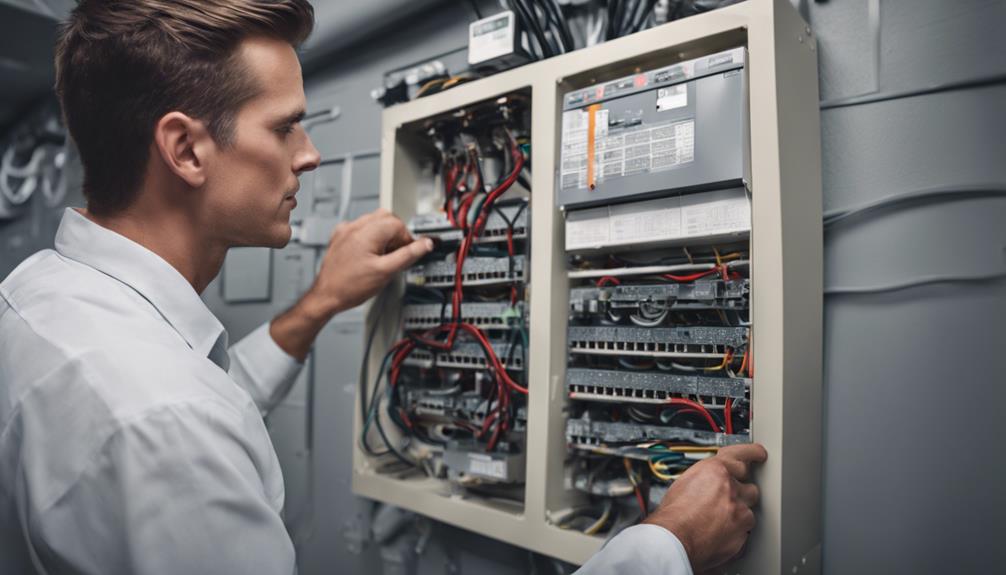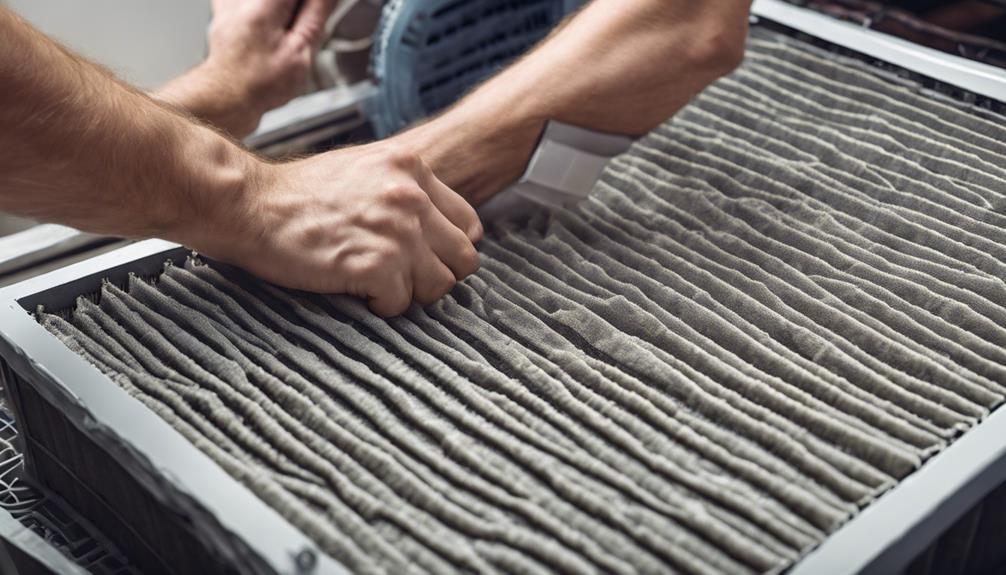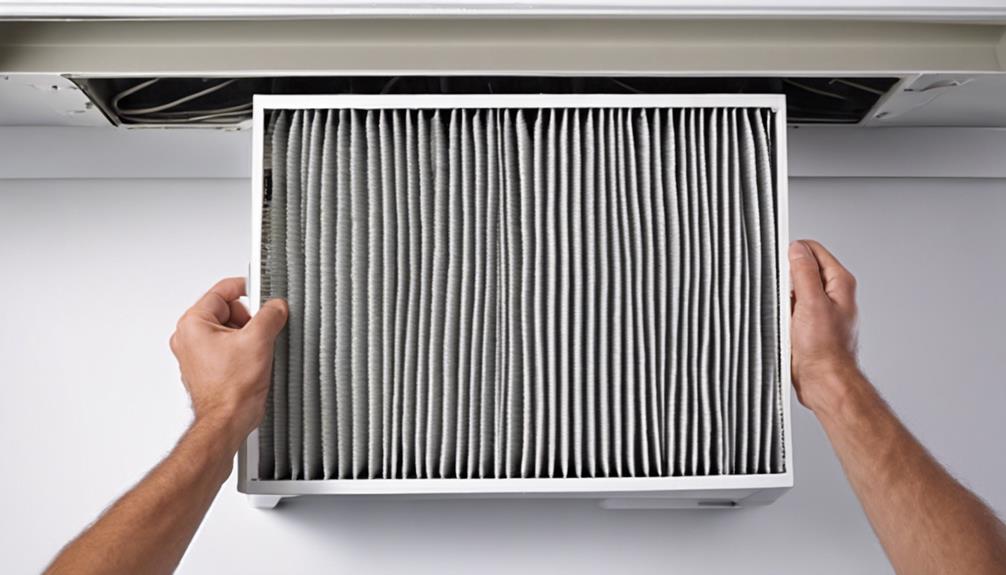Ensuring good air quality in your home is essential for creating a healthy living space. One easy method to achieve this is by regularly replacing your air filters.
However, many individuals overlook this simple yet impactful task. By following a few uncomplicated steps, you can significantly enhance the air quality in your home. These steps not only contribute to a healthier living environment but also have additional benefits that may surprise you.
Key Takeaways
- Proper sizing ensures optimal filtration and system performance.
- Turn off power supply before replacing to prevent accidents.
- Dispose of old filters properly to avoid spreading contaminants.
- Securely install the new filter for improved air quality in your home.
Properly Size Your New Air Filter
To ensure optimal air filtration efficiency and system performance, it is essential to properly size your new air filter by accurately measuring the actual opening in your furnace. The nominal size of an air filter is typically 1/2 inch smaller than the actual size to guarantee a proper fit.
Measure the existing filter in your furnace to determine the correct nominal size for your new air filter. Checking the fit of the new air filter before purchasing is crucial to avoid any installation issues. Custom sizes may need to be considered if your furnace requires a non-standard air filter to maintain optimal efficiency.
Selecting the correct size air filter is fundamental in ensuring effective air filtration and system performance. By accurately sizing your air filter based on the actual dimensions of the opening in your furnace, you can enhance the overall air quality in your home while maintaining the efficiency of your HVAC system.
Turn off the Power Supply

Ensure safety and prevent electrical mishaps by locating and turning off the power switch next to the furnace before initiating the air filter replacement process. In cases where the power switch is not visible, it is imperative to disconnect the power at the fuse box to ensure the power supply is completely disconnected. Prioritizing safety through disconnecting the power supply is crucial to prevent any accidents or mishaps during the replacement of the air filter in your HVAC system.
To emphasize the importance of turning off the power supply before replacing the air filter, consider the following:
- Prevent Accidents: Turning off the power eliminates the risk of electrical shocks or other mishaps while handling the air filter.
- Electrical Safety: Ensuring the power is off enhances electrical safety and reduces the likelihood of accidents.
- Protect HVAC System: Disconnecting the power supply safeguards the HVAC system components from potential damage that could occur if the power is left on.
Remove and Dispose of Old Filter
When removing the old filter, it is essential to carefully note the airflow direction arrow to ensure correct installation of the new filter. This arrow indicates the direction of airflow through the system and should be replicated when inserting the replacement filter.
To properly remove the old filter, turn off the HVAC system to prevent any particles from circulating during the process. Place the old filter into a garbage bag to contain any dust and debris, maintaining indoor air quality.
Understanding MERV ratings, which indicate filter efficiency, is crucial when selecting a new filter. Proper disposal of the old filter is essential to prevent spreading contaminants in the air and maintaining a clean environment.
Insert New Air Filter

Upon securing the correct replacement filter, carefully align the airflow direction arrow with the corresponding indicator in the system before inserting the new filter. Installing the new air filter is a crucial step in maintaining good air quality in your home.
Here are some key points to consider:
- Air Flow Alignment: Ensure that the airflow direction arrow on the new filter matches the airflow direction of the HVAC unit to optimize filtration efficiency.
- Proper Fit: The size of your filter matters. Installing a filter that is too small or too big can lead to air bypass, reducing the effectiveness of filtration.
- Filter Maintenance: Regularly replacing the air filter is essential for preventing the circulation of dirty air and maintaining a healthy indoor air environment.
Secure the Cover and Power Back on
To complete the air filter replacement process, securely attach the cover grille by engaging the latch mechanism and then restore power to the HVAC system. Securing the cover grille is crucial to ensure that the filter remains in place, preventing air leaks that can compromise system efficiency. Properly hooking the latch into place not only maintains the filter's position but also helps in maintaining indoor air quality by preventing air bypass. Additionally, it is essential to double-check that the filter is correctly positioned, with the airflow arrow pointing in the right direction to optimize airflow within the HVAC system.
Once the cover grille is securely fastened, the next step is to restore power to the HVAC system. By doing so, the system can resume normal operation with the new filter in place. This final step completes the process of replacing the air filter in your home, ensuring that your HVAC system operates efficiently and maintains good indoor air quality.
Frequently Asked Questions
How Often Should Air Filter Be Changed?
Air filters should be changed every 30 to 90 days for optimal performance. During peak seasons or with pets/allergies, consider monthly changes. Regular replacements improve air quality and HVAC efficiency, minimizing energy consumption. Follow manufacturer guidelines for optimal results.
How Do I Know if My Air Filter Needs Replacing?
Determining the need for air filter replacement involves assessing visible debris, measuring airflow restriction, observing decreased airflow from vents, monitoring energy consumption, and adhering to a replacement schedule. Regular checks ensure optimal air quality and system efficiency.
Can You Change Air Filter Yourself?
Yes, changing an air filter yourself is a feasible task that requires minimal tools and time. It can be done by following manufacturer's instructions and safety precautions. Regularly replacing air filters every 30 to 90 days enhances indoor air quality and HVAC system efficiency.
How Much Should an Air Filter Change Cost?
The cost of an air filter change varies based on filter type, ranging from $10 to $50 or more. Annual expenses for standard filters typically range between $120 to $240. Consider bulk purchases for long-term savings.
Conclusion
In conclusion, replacing air filters in your home is a simple yet essential task for maintaining good indoor air quality and prolonging the lifespan of your HVAC system.
By following the five easy steps outlined in this article, you can ensure efficient system operation and lower energy consumption.
Remember, a stitch in time saves nine when it comes to air filter maintenance.
Ava combines her extensive experience in the press industry with a profound understanding of artificial intelligence to deliver news stories that are not only timely but also deeply informed by the technological undercurrents shaping our world. Her keen eye for the societal impacts of AI innovations enables Press Report to provide nuanced coverage of technology-related developments, highlighting their broader implications for readers.










